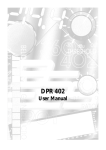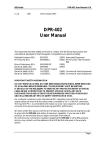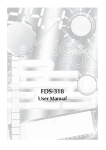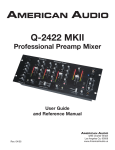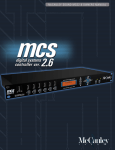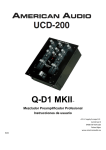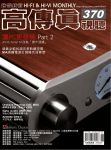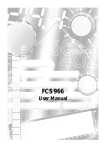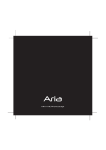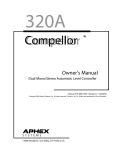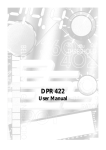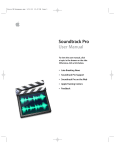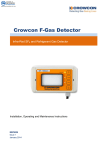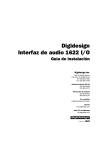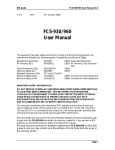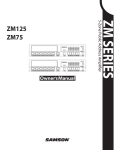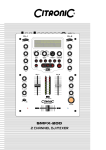Download DPR-504 User Manual version 4.0
Transcript
BSS Audio V 4.0 DPR-504 User Manual version 4.0 JMK 1 December 1997 DPR-504 User Manual This equipment has been tested and found to comply with the following European and international Standards for Electromagnetic Compatibility and Electrical Safety: Radiated Emissions (EU): RF Immunity (EU): EN55013 EN50082/1 Mains Disturbance (EU): Electrical Safety (EU): Radiated Emissions (USA): Electrical Safety (USA): Electrical Safety (CAN): EN61000/3/2 EN60065 FCC part 15 Class B UL813/ETL UL813/ETLc (1990) Associated Equipment (1992) RF Immunity, Fast Transients ESD (1995) (1993) (1996) Commercial Audio Equipment (1996) Commercial Audio Equipment IMPORTANT SAFETY INFORMATION DO NOT REMOVE COVERS. NO USER SERVICEABLE PARTS INSIDE, REFER SERVICING TO QUALIFIED SERVICE PERSONNEL. THIS EQUIPMENT MUST BE EARTHED. IT SHOULD NOT BE NECESSARY TO REMOVE ANY PROTECTIVE EARTH OR SIGNAL CABLE SHIELD CONNECTIONS TO PREVENT GROUND LOOPS. ANY SUCH DISCONNECTIONS ARE OUTSIDE THE RECOMMENDED PRACTISE OF BSS AUDIO AND WILL RENDER ANY EMC OR SAFETY CERTIFICATION VOID. For continued compliance with international EMC legislation ensure that all input and output cables are wired with the cable screen connected to Pin 1 of the XLR connectors. The input XLR Pin 1 is connected to the chassis via a low value capacitor, providing high immunity from ground loops whilst ensuring good EMC performance. We have written this manual with the aim of helping installers and sound engineers to get to grips with the DPR-504 and obtain its maximum capability. If you are new to BSS products, we recommend that you begin at the start of the manual. We welcome any comments or questions regarding the DPR-504 or other BSS products, and you may contact us at the address or World Wide Web site given in the warranty section. Page 1 BSS Audio DPR-504 User Manual version 4.0 Contents 1 Introduction 3 2 Unpacking 4 3 Mechanical installation 4 4 Mains power connection 4 5 Audio connections 5 5.1 Main inputs 5.2 Main outputs 5.3 EXT Key input 6 6 6 6 Getting started 7 7 Operating instructions 8 7.1 Filter and width 7.2 Key listen 7.3 Threshold 7.4 Key level meter 7.5 Gate open indicator 7.6 Attack, release and hold 7.7 Range 7.8 Link 7.9 EXT 7.10 IN 8 9 9 10 10 11 12 12 13 13 8 Service section 8.1 Transient suppressor replacement 8.2 Separating signal and chassis ground 14 14 14 9 Warranty Information 15 10 Specifications 16 10.1 Input section 10.2 Output section 10.3 Operating controls 10.4 Metering 16 16 16 17 Page 2 BSS Audio DPR-504 User Manual version 4.0 1 Introduction The BSS DPR 504 is a four channel professional noise gate which has been designed for simple and intuitive use, and yet is capable of producing the best results in a wide range of applications. It incorporates modern integrated circuit technology for high packing density and long term reliability. Some of the more advanced features within the product are not necessarily obvious from the front panel, and to ensure the unit is used to its fullest, it is recommended that the manual is read thoroughly. Ingenious proprietary techniques are employed to make the engineers life easier without compromise to performance or versatility. A summary of its features are highlighted below, with a more in depth discussion following within the manual. • Four independent channels that are linkable to give either one or two stereo linked master/slave modes. • Flexible parametric Key filter for frequency conscious gating with absolute precision. The parametric EQ approach provides a higher degree of control for accurately rejecting spurious unwanted gate triggers than similar shelving filters. • Key listen provides operator with the facility to hear the effect of Key side-chain EQ or other processing effect as an aid to setting up. • Dual metering system which indicates both average and peak responses simultaneously and gives the operator precise information regarding the signal levels around the threshold point. Separate 'gate open' marker LED, linked to gate dynamics, continually monitors interrelation between gate activity and the actual signal. • IN switch which allows the operator to force open the gate, in the absence of signal, to check the integrity of the signal lines, and observe set dynamics. This also functions as channel bypass. • Selectable 'Fast and auto' attack modes which have been optimised for accurate and transparent performance over the widest variety of program material. Self adjusting Auto mode deals cleanly with varying dynamics whilst a super fast mode is available for demanding percussion and synthesiser transients. • Simple to operate, combined Hold and Release control which has special audio- tapered characteristics to give subtle 'musical' envelope shaping. • Rear mounted electronically balanced XLR input and output connectors. • Rear mounted 1/4" jack socket allows access to external side-chain key input for uses such as external EQ, delay or keying by and unrelated signal. Page 3 BSS Audio DPR-504 User Manual version 4.0 2 Unpacking As part of the BSS system of quality control, we check every product carefully before packing to ensure that it reaches you in flawless condition. Before you go any further, please check the unit for any physical damage and retain the shipping carton and all relevant packing materials for use, should the unit need returning. In the event that damage has occurred, please notify your dealer immediately, so that a written claim to cover the damages can be initiated. Check out section 9; Warranty Information for more info on the warranty, and also to record your dealer details. 3 Mechanical installation A vertical rack space of 1U (1 3/4"/44.5mm high) is required, with a depth of 220mm, excluding connectors. Ventilation gaps are unnecessary. If the unit is likely to undergo extreme vibration through extensive road trucking and touring, the unit must be supported at the rear and/or sides to lessen the stress on the front mounting flange. The necessary support can generally be bought ready-built, as a rack tray, or the DPR 504 can be mounted between other units. Damage caused by insufficient support is not covered by the warranty. To prevent cosmetic damage to the front panel paint finish, always use protective plastic cups under the rack mounting bolts. As with any low-level signal processing electronics, it is best to avoid mounting the DPR 504 next to a strong source of magnetic radiation or heat, for example, a high power amplifier. The internal power supply regulators are mounted on the case sides and use this as their heatsink. After a period of time in an enclosure, the metal case will feel hot to the touch, but this is quite normal and should not be cause for alarm. 4 Mains power connection WARNING! THIS APPLIANCE MUST BE EARTHED. The DPR 504 must always be connected to a 3-wire earthed AC outlet. The rack framework must also be connected to the same grounding circuit. The unit must NOT be operated unless the power cables' EARTH (ground) wire is properly terminated - this is important for personal safety as well as for proper control over the system grounding. Page 4 BSS Audio DPR-504 User Manual version 4.0 The wires in the mains lead are colour coded in accordance with the following code. Green and Yellow......Earth Blue......Neutral Brown......Live Those units supplied to the North American market will have an integral moulded 3 pin connector which is provided to satisfy required local standards. IMPORTANT: The DPR 504 is designed to use 50/60Hz AC power in one of two voltage ranges, selectable with the mains voltage selector switch on the rear of the unit. It is vital that the position of this switch is checked BEFORE initial power up to ensure that it matches the local mains supply. Acceptable input AC supply voltages range from: 120V switch position 240V switch position @@V to @@V @@V to @@V The application of voltages outside these ranges may cause permanent damage or erratic operation of the unit, and will invalidate the warranty. The mains fuse carrier on the rear of the unit must be fitted with the correct type and rating of fuse, depending on the position of the mains voltage selector switch: 120V switch position 240V switch position T250mA fuse T200mA fuse In the unlikely event of the mains fuse failing without good reason, DISCONNECT THE UNIT FROM THE MAINS SUPPLY, and always replace with the appropriately rated fuse (as specified above) for continued protection against damage and fire. Note: For USA and Canadian users, the replacement fuse must be of an identical UL rated type fuse for continued compliance with safety standards. It is very unlikely that fuses will blow during normal use, but if replaced fuses continue to blow, then the internal transient suppressors may have become damaged. If this case, you should refer to section 8.1 for the replacement procedure. 5 Audio connections The DPR 504 is designed to operate at nominal line levels and not at microphone signal levels. The gating of microphone signals must be done after the mic-amp, or gain increase section of a mixing console input channel, and would generally occur at the pre-fader or pre-equaliser insert point of the particular channel. We would recommend all wiring to be done with two-conductor shielded cable. The shield should not carry any signal currents, and be used only for shielding. It is ordinarily connected to a ground point at one end only. Page 5 BSS Audio DPR-504 User Manual version 4.0 5.1 Main inputs The electronically balanced input of each channel is compatible with all professional and semi-professional sound equipment, balanced or unbalanced, whose source impedance is 600 ohms or less. The nominal input level is between 10dBv and +10dBv, with an upper maximum or +20dBv. There is no internal connection to the Pin 1 terminal, and therefore the cable shield grounding must be derived from the source equipment. This arrangement provides an automatic break in the grounding of interconnected equipment and will ensure noiseless operation of the equipment. If European 4 conductor cable is being used for interconnections, then special attention must be given to avoiding earth loops through multiple chassis ground connections. For non standard connections, such as unbalanced lines, remember: • Always use Hot '+' and Cold '-' signal pins as the two input terminals. • When driven from an unbalanced source, connect the '-' terminal to the source ground connection, as well as to the shield of the cable. • When driven from a balanced source, connect the cable shield to chassis ground at the source end only. 5.2 Main outputs The outputs of each channel are electronically balanced and floating, and provide ample power to drive all professional and semi-professional audio equipment whose input impedance is 600 ohms or greater. The nominal input impedance will be the same as the input level when the gate is 'open', as the DPR 504 makes no gain contribution. The maximum output level is +20dBv into a load of 600 ohms. Should an unbalanced output be required, then the Cold '-' pin must be connected to Pin 1 to ensure no loss of output level. For some rack mounted systems, the chassis or safety power ground might need to be isolated from the signal ground. Reference should be made to section 7.2; Key listen for further information. 5.3 EXT Key input This rear mounted 1/4" RTS jack socket provides an input to the key side chain. Refer to section 7.9; EXT for an explanation of its use and operation. Wiring is shown for a mono plug, as the input is unbalanced. However, an RTS stereo plug will be automatically unbalanced when inserted. Page 6 BSS Audio DPR-504 User Manual version 4.0 6 Getting started The instructions in this section are intended to help those people unfamiliar with noise gates and their terminology, and to provide a means of 'getting started'. The DPR 504 has been designed to need the minimum of operator knowledge and setup procedures, and is capable of producing excellent results with the adjustment of only one control. The front panel is divided equally into four identical sections, with each section, or channel, being numbered on the IN switch. There is no difference in operation between any of the four channels except in respect of LINK switching. This is covered separately in section 7.8. The following discussions apply to all channels equally. In operation, the DPR 504 can be considered as an automatic on-off switch that is placed into the signal line. The switching operation is controlled by the loudness level and the frequency content of the signal. The best way to understand its basic operation is to connect one channel to a program source and operate the controls whilst listening to their effect. Connect a suitable program source, such as a CD player, to one of the channel inputs and a suitable monitoring system to the same channels output. Section 5; Audio connections shows the correct wiring configurations. • Set • Set • Set • Set • Set all the switches to their 'out' positions. the threshold control to 'out'. the release control to 1 sec. the key filter control to 1kHz the width control to 10. The gate open triangular LED will be illuminated and the program signal should be heard at the same level as if it were not connected through the gate channel. This condition is known as 'bypass', and the gate is being forced to remain open and pass the program unaffected. Now push the IN switch. The red LED underneath will illuminate to confirm that the gate is now in control, and the program signal level will drop to very nearly nothing. The gate has closed and is cutting off the signal. Now slowly rotate the threshold control anticlockwise and an indication will start to show on the key level meter. Note that this display has two parts - a single segment ahead of a bar display (refer to section 7.4; Key level meter for more detail). The single segment is responding to the peaks of the program material, and the bar display is indicating the average volume level of the program. As soon as the display exceeds the 'gate open' marker, the program signal will be passed through to the output and the gate has 'opened'. Spend a few minutes adjusting this control and watching the display. Page 7 BSS Audio DPR-504 User Manual version 4.0 For close-mic gating, as would be used on acoustic drums, the threshold trigger point should be set close to the signal peaks to avoid spill triggering effects from adjacent drums. In other applications, such as to remove low level background electronic noise, a threshold trigger point might be used that is a long way down from the program signal peaks to avoid losing any quiet passages. Each application will require a slightly different approach to be used, and the key level meter has been designed to provide accurate information for a whole range of operation methods. The threshold control is the most important control on the gate and is the only one that will need adjusting to perform simple gating. These controls can be separated into three classifications depending on their function and usage on the gate. Key functions are those that help to determine how to open the gate. Dynamic functions are those that determine when to open and close the gate. Mode functions are those that determine why the gate opens and by how much. Control classification: Key functions : Key filter, Width, Key listen, Threshold, Key level meter. Dynamic functions : Attack, Release, Auto Attack. Mode functions : Int/ext, Range, Link, IN. Section 7 describes in more detail how these functions work and how best to set them for particular tasks. Remember that automatic channel switching, such as gating, can have many uses other than simple cleaning up applications for noisy microphone lines etc., don't be afraid to experiment. 7 Operating instructions 7.1 Filter and width These two controls adjust the internal key side-chain filters. These filters are used to control the frequency content of the signal being sent to the gate control circuitry and allow the filtering-out of information not required to control the gating action. They are not placed in the main signal path, and therefore have no effect whatsoever on the program material. In use, the filters should be considered as a pair of tracking high pass and low pass filters, with the space between them controlled by the width control. Thus it is possible to achieve a variety of key sidechain filter responses from a very broad filter set giving a wide band response, to a quite narrow set for a very selective response. The frequency scaling around the key filter control knob is the approximate value for the centre of the response, without regard to the octave value set by the width Page 8 BSS Audio DPR-504 User Manual version 4.0 control. In use, the user should commence with a fairly wide width setting, and then progressively narrow the response down whilst sweeping the frequency to isolate the dominant frequency of the program, thus rendering the threshold control sensitive only to the required signal. This type of filter realisation not only allows band-pass filter configurations, but also the conventional low pass or high pass configurations by the appropriate setting of the key filter and width control. Experience will show that this approach gives considerable operational advantages for the user over the more elementary separate low/high pass filter approach. In application, the frequency response of the filter is set to coincide with that of the signal to be gated, or a smaller but stronger part of it that is always present. This will ensure for example, on microphone signals, that out of band information close in level to the required signal will not cause spurious openings of the gate. Should this facility not be required then the controls should be set as indicated in the section 6; Getting started. 7.2 Key listen This momentary switch allows the operator to listen to the program material after it has been processed by the key filters. This also applies to any external equipment connected via the EXT key input socket. In application it would be used during the setup of the side-chain key filter and width controls, as it is often easier to more accurately set them whilst listening to their effect. The key listen signal appears at the output connector of the channel, and overrides the normal program material. In this sense it must be used with caution, as accidental operation will cause temporary loss of program signal at the output connector. 7.3 Threshold As previously mentioned in 'getting started', the threshold control is one of the most important functions on any gate, and is used to set the level at which the gate open sequence will commence, in relation to the input program signal level. With the control fully clockwise, at 'out', the gate will be held closed at all times, and as the control is rotated counter-clockwise, the threshold point is progressively reduced until at the -50dBv scale setting, the gate would be virtually open at all times. In application the control should be set to give the required degree of low level signal block. The key level meter is used in conjunction with this control as it gives precise information relating to this setting. Page 9 BSS Audio DPR-504 User Manual version 4.0 7.4 Key level meter The total key side-chain signal level, after any external processing, is displayed on this meter in two modes: as a bar indicating the average signal level, and as a single segment indicating the instantaneous peak level. The peak level always exceeds the average level and is displayed as a moving dot above the average column, in a simultaneous manner. The dynamics of this display are optimised for user visibility and accuracy, with the peak dot exhibiting a damped decay response like a PPM meter. The meter scale is centred around a 0dB calibration point which corresponds to the level that initiates the 'gate open' sequence. Rotation of the threshold control moves the key side-chain signal into this meter 'window', and gives the operator a real-time picture of the relative position of the signal in relation to the point at which the gate will trigger. It is important to remember that this meter is showing the side chain signal, and not the actual opening and closing of the gate. This is indicated by the triangular gate open marker LED underneath. The meter scale is designed to allow sufficient usable range both below and above the gate open point. In application when the program signal is present, the meter will show below full scale but above the threshold gate opening point. When the program signal is not present, the meter will show spurious background noise at a level which is below the 0dB scale point, and therefore not opening the gate. For very 'safe' gating such as for vocals, the signal will show nearer full scale, and for critical close-mic gating such as for drums, the signal peaks will show only a few dBs above the 0dB threshold point. 7.5 Gate open indicator The triangular LED mounted underneath the 0dB scale point of the key level meter is provided to give a visual indication of the actual activity of the gate at all times. This does not necessarily correspond to the key signal passing the 0dB meter scale point, as the various dynamic controls of the gate modify this correlation. The dynamic response of this gate open indicator matches that of the gate action, and thus is dependent on the attack and release control settings. If for example, the release control is set at 1 sec, then this LED will be seen to remain on, and therefore the gate to remain open, for a period of one second following the side chain key level meter display falling below the 0dB point. In application it is good practice to periodically monitor the operation of this LED in conjunction with the key level meter display, to check for consistency of operation and to anticipate potential problems more easily. Page 10 BSS Audio DPR-504 User Manual version 4.0 7.6 Attack, release and hold These two controls (attack & release) determine how the gate responds, in time, once it has received instructions to open or close. Attack is the time taken for the gate to fully open once threshold level has been exceeded. This opening sequence will continue, once triggered, even if the signal level falls below threshold during the cycle. Release is the time taken for the gate to fully close once the signal has dropped below threshold. Contrary to attack, this closing sequence will be overridden should the signal level rise above threshold during the cycle. Within gating terminology there is another timing sequence which is called hold. Hold is a period of time for which the gate will remain fully open once the signal has dropped below threshold level, and is necessary to avoid the gate 'chattering' on and off during natural short pauses in program material, such as speech. It always precedes the start of release. To minimise operator set up time, the DPR 504 incorporates the hold function by combining it with the release function. These two functions still remain independent, however their adjustments have been combined onto the one control. In general, at small release time settings the hold time will be small; at longer release times the hold time will be correspondingly longer. The auto attack facility of the DPR 504 will cover all but the most transient of program sources, and has been carefully optimised to produce good envelope control. For super fast attack times, the user can select the fast position. The release control can be set to around 1 second for many applications, but provides control over a wide range to allow more critical tuning in sensitive applications. The decay contour has been given a special audio taper which ensures that even relatively fast releases can occur unobtrusively and musically. It is also highly operator fault tolerant, and the user will soon appreciate the improvement this makes over the more conventional linear or logarithmic decay. The audible character of any release setting is significantly altered by changing the range (refer to section 7.7; Range) between -70dB and -20dB. Whilst the -20dB setting provides sufficient attenuation for effective but more gentle gating than the 70dB range, it also gives the audio tapered release envelope a subtly different musical feel. For a given release time setting, the gate has less 'far to go' on the 20dB range setting, and this variation effectively doubles the range of decay contour options available to the operator. Notice, that once the attack sequence has been initiated by an event (that is the key side-chain signal has exceeded 0dB on the key level meter) it will continue through to the end of the timing cycle regardless as to whether the key signal has since fallen below 0dB threshold. Page 11 BSS Audio DPR-504 User Manual version 4.0 Similarly, the hold sequence continues for its set duration, and avoids the starting of another attack sequence should the key signal momentarily fall below 0dB threshold. Release will commence following the ending of a complete hold timing period, but it will be overridden by another attack sequence should this be initiated by a subsequent event. 7.7 Range This switch sets the difference in program signal level between its value when the gate is open to that when it is closed, and is marked in dBs. The output program signal level when the gate is open is the same as the input level, and is taken to be 0dB relative. When the gate is closed, the range switch allows the program level to be set to either -20dB or -70dB of this gate open level. In application, when the switch is set to -20dB, the gate action will be very much like a 'dim' function. This is ideal for use when cleaning up acoustic microphone lines and other noisy sources during live sound reinforcement shows. When the switch is set to -70dB, the gate action will be very much 'on-off'. This is needed in applications where signals are to be switched on and off under dynamic control, and in studio recording environments where electronic noise from amplifiers and keyboards need to be eliminated. It is worth noting that the effective audible attack time will be shorter for the -20dB range setting than for the -70dB setting, as it will take longer for the gate to rise from a level of -70dB to 0dB, than from -20dB to 0dB for the same fixed attack time. 7.8 Link Both channel 2 and channel 4 on the DPR 504 have a push switch which alters the normal operational mode of the unit from four separate channels of gates into one in which channel 1 plus 2 and channel 3 plus 4 work together. The first group is operated by the controls of channel 1 only; the second group is operated by the controls of channel 3 only. The two switches work independently of each other so that the unit can be configured as two groups of two channels, or one group of two channels and two independent channels. The associated LED on channel one and three indicate that they are working as the master control for the group. When this mode is selected, the key side-chain signals from both the group channels are summed together to provide a common mono signal. This is then used by the master channel of the group for processing in the normal manner. In addition, the VCA on the other group channel (slave channel) is disabled from its own drive circuitry and connected in parallel with that of the master channel, such that the action of the slave channel is now totally controlled by the master. Page 12 BSS Audio DPR-504 User Manual version 4.0 If it is not required for the side-chain key signal of the slave channel to be summed with that of the master channel, or visa versa, then the respective EXT switch should be pressed. This then disconnects that channels signal - provided nothing is externally connected to the rear panel external key input jack socket. In application, it might be necessary to use the master/slave linking facility when using two channels of the unit on a stereo program source. It can also be useful when gating two microphone lines from similar sources, such as backing vocals or orchestral overheads, or when gating stereo effects returns or submixes from other program sources. 7.9 EXT This switch selects the signal source for the key side-chain. In the normal 'out' position, the signal path is continuous, and the side-chain uses the normal program material appearing at the input connector as its control. If the EXT (external) position is chosen, then the key side-chain looks to the rear mounted jack socket marked EXTernal key input for its source of signal. This allows the gate to be triggered by an event that is not the same program event connected to the input connector. In application this allows the gate channel to be controlled by two other methods. Firstly, a totally independent signal can be connected at this point, such that the gate will be triggered open by an event which is not related to the program appearing at the input connector. Secondly, extra equalisation, or time delay can be added with the existing internal signal to enhance the selectiveness of the gate switching. 7.10 IN This switch selects whether the gating action is active or not. When the switch is 'out', the gate will be held permanently closed allowing the program signal to pass uninterrupted. When the switch is depressed, the gate will be active and controlled by the key level signal. In application this switch can be used to check that signal lines are active, or to temporarily suspend the action of the gate. Repeated switching will also allow checking of the dynamic action of the gate, as the set attack and release times will be operative on the opening and closing sequences. Page 13 BSS Audio DPR-504 User Manual version 4.0 8 Service section 8.1 Transient suppressor replacement The primary of the input transformer is protected against high voltage spike interference by two voltage dependent resistors (VDR). These provide a momentary short circuit to voltage peaks in excess of the normal power voltage rating. Should the DPR 504 be inadvertently connected to 3-phase line/line voltages or to 240V when selected for 120V, or any other incorrect voltage, these suppressors are likely to fail in a short circuit mode. This will be demonstrated by repeated mains fuse failure at power up. Even in this case of extreme over-voltage, the DPR 504 is protected against failure, and the simple removal of the damaged suppressors will allow the unit to be used again. It is important, however, that they are replaced immediately to ensure continued protection. Before attempting to remove the damaged suppressors, ensure that the unit is unplugged and totally isolated from any power supply. 8.2 Separating signal and chassis ground In some installations, it might be necessary to separate the electronic signal 0V ground from the chassis ground to avoid earth loops. Since both the inputs and outputs of the DPR 504 are balanced, correct connector wiring should be alleviate this problem. Prior to continuing with this procedure, it is recommended that you recheck all audio wiring for correctness. Should it be necessary, then the simple removal of an internal wire link accomplishes this task. To remove the wire link, you will need to remove the top cover of the unit, and then remove the top PCB, and 4 LED PCBs. The chassis link point will then be accessible, located between C512 and C502 labels (white silk screen) on the main PCB. On no occasion should the incoming safety ground wire be disconnected from the line cord or from the internal chassis connection as an alternative to this procedure. Page 14 BSS Audio DPR-504 User Manual version 4.0 9 Warranty Information When sold to an end user by BSS Audio or a BSS Audio Authorised Reseller, this unit is warranted by the seller to the purchaser against defects in workmanship and the materials used in its manufacture for a period of one year from the date of sale. Faults arising from misuse, unauthorised modifications or accidents are not covered under this warranty. No other warranty is expressed or implied. If the unit is faulty it should be sent to the seller of the equipment, in its original packaging with shipping prepaid. The unit will be returned to you when the repair has been completed. If the unit was purchased in the European Union, you may, as an alternative, return the unit to any other BSS distributor in the European Union. You should include a statement listing the faults found. The unit’s serial number must be quoted in all correspondence relating to a claim. We recommend that you record your purchase information here for future reference. Dealer Name: Dealer Address: Post/Zip Code: Dealer Phone No.: Dealer Contact Name: Invoice/Receipt No.: Date of Purchase: Unit Serial Number: In keeping with our policy of continued improvement, BSS Audio reserves the right to alter specifications without prior notice. The DPR-504 was designed and developed by BSS Audio, Hertfordshire, England. Phone (+44) (0)1707 660667. Fax (+44) (0)1707 660755. World Wide Web address: http://www.bss.co.uk Page 15 BSS Audio DPR-504 User Manual version 4.0 10 Specifications 10.1 Input section Impedance Headroom CMRR Connector Balanced 12k ohm differential +20dBv >-50dB 20Hz-20kHz XLR3-31 or equivalent style 10.2 Output section Impedance Headroom Frequency Response Noise Balanced and floating to drive 600 ohm loads +20dBv into 600 ohm load +/-1dB 20Hz to 20kHz. Ultrasonic low pass filter -3dB at 32kHz Measured to CCIR 468-2 Zero attenuation <-86dBv Maximum attenuation <-90dBv Distortion THD <0.05% 20Hz to 20kHz SMPTE IM <0.02% Connector XLR3-32 or equivalent style 10.3 Operating controls Key filter Key width Key source Threshold Attack Release Range Link EXT Socket Variable between 100Hz and 20kHz centre frequency Variable between 0.5 and 10 octaves Switchable internal or EXTernal via 1/4" RTS jack Variable between +20dBv and -50dBv Audio attack switchable FAST (20uS) or AUTO (40uS 5mS) program dependant Combined Hold/Release function variable 1mS to 4S Hold period tracks proportionally with release Release has custom audio taper Switchable attenuation between -70dB and -20dB Stereo linkable in pairs; channel 1/2 and channel 3/4 Channel 1 and 3 become masters 3 pole 1/4" RTS jack socket to provide unbalanced access into key side chain Page 16 BSS Audio DPR-504 User Manual version 4.0 10.4 Metering Key level Simultaneous average and peak reading 12 point LED display showing 28dB range of Key side-chain signal Gate open Single triangular LED showing exact gate status Mimics response profile as set by attack and release controls. Page 17

















